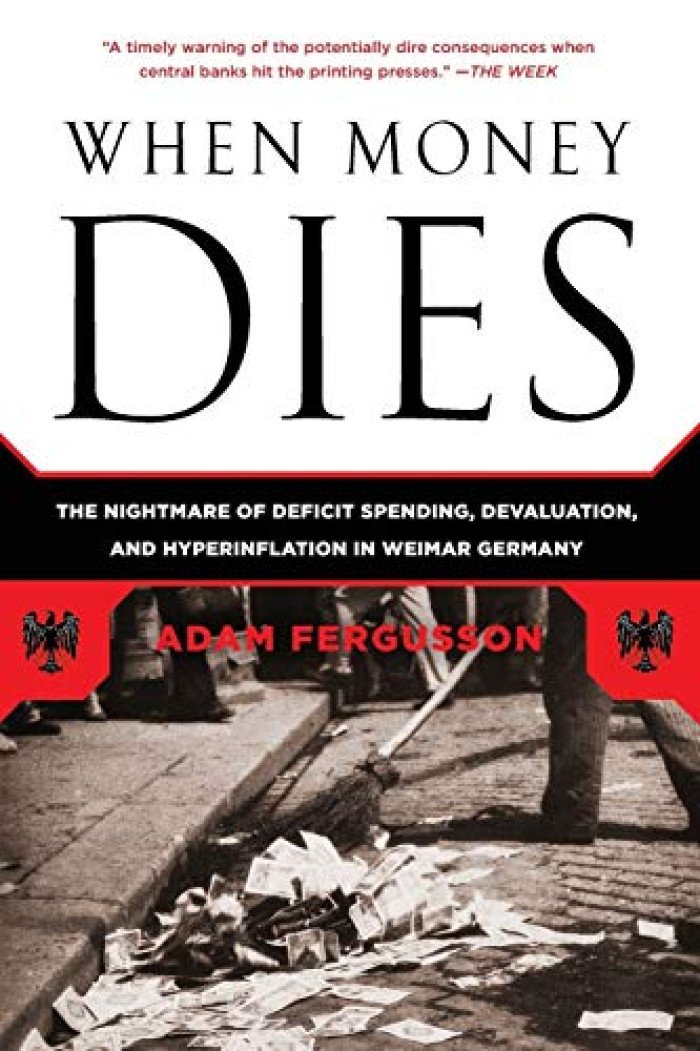
Support the author by purchasing this book with the link below!
PurchaseWhen Money Dies
Adam Fergusson
Published: 2010
When Money Dies: The Nightmare of Deficit Spending, Devaluation, and Hyperinflation in Weimar Germany is a book by Adam Fergusson that offers a historical account of the events that led to hyperinflation in Germany in the early 1920s. The book provides a cautionary tale of how unchecked deficit spending, devaluation, and hyperinflation can lead to social and political unrest.
The book begins by introducing the political and economic situation in Germany after World War I. The Treaty of Versailles had imposed huge reparation payments on Germany, which put a strain on the country's economy. The German government resorted to printing more money to meet its obligations, which led to inflation. The inflation rate continued to rise, and the value of the German mark plummeted. Prices of goods and services increased exponentially, making it difficult for people to afford basic necessities.
As hyperinflation set in, the value of the German mark became practically worthless. People resorted to bartering and black markets to survive. The social fabric of Germany broke down, with people struggling to survive. The rise of extremist political parties, such as the Nazi party, was partly attributed to the economic and social turmoil caused by hyperinflation.
Fergusson provides vivid examples of how people's lives were affected by hyperinflation. For instance, he describes how it took wheelbarrows full of banknotes to buy a loaf of bread, and how people burned money to keep warm. The book also explores the social and political implications of hyperinflation. It led to a breakdown of the social fabric, with people resorting to bartering and black markets to survive.
Throughout the book, Fergusson provides valuable insights into the economic policies and decisions that led to hyperinflation in Germany. He explores the role of the central bank, the government, and other key players in the inflation crisis. He also offers valuable lessons for policymakers and economists today. The book illustrates how unchecked deficit spending, devaluation, and hyperinflation can lead to social and political unrest.
The book begins by introducing the political and economic situation in Germany after World War I. The Treaty of Versailles had imposed huge reparation payments on Germany, which put a strain on the country's economy. The German government resorted to printing more money to meet its obligations, which led to inflation. The inflation rate continued to rise, and the value of the German mark plummeted. Prices of goods and services increased exponentially, making it difficult for people to afford basic necessities.
As hyperinflation set in, the value of the German mark became practically worthless. People resorted to bartering and black markets to survive. The social fabric of Germany broke down, with people struggling to survive. The rise of extremist political parties, such as the Nazi party, was partly attributed to the economic and social turmoil caused by hyperinflation.
Fergusson provides vivid examples of how people's lives were affected by hyperinflation. For instance, he describes how it took wheelbarrows full of banknotes to buy a loaf of bread, and how people burned money to keep warm. The book also explores the social and political implications of hyperinflation. It led to a breakdown of the social fabric, with people resorting to bartering and black markets to survive.
Throughout the book, Fergusson provides valuable insights into the economic policies and decisions that led to hyperinflation in Germany. He explores the role of the central bank, the government, and other key players in the inflation crisis. He also offers valuable lessons for policymakers and economists today. The book illustrates how unchecked deficit spending, devaluation, and hyperinflation can lead to social and political unrest.
1. Unchecked deficit spending can lead to hyperinflation: When a government prints money to meet its financial obligations without regard to the consequences, it can lead to hyperinflation. In Germany, the government's attempts to meet its reparation payments by printing more money led to a breakdown of the economy and social fabric.
2. Hyperinflation can have devastating effects: Hyperinflation can make money practically worthless and make it difficult for people to afford basic necessities. In Germany, people had to resort to bartering and black markets to survive.
3. Social and political instability can arise from hyperinflation: Hyperinflation can lead to a breakdown of the social fabric and cause social and political unrest. In Germany, the rise of extremist political parties, such as the Nazi party, was partly attributed to the economic and social turmoil caused by hyperinflation.
4. Central banks and governments have a responsibility to maintain economic stability: When economic instability arises, it is the responsibility of central banks and governments to take measures to maintain economic stability. In Germany, the central bank and the government failed to take decisive action to address the inflation crisis, which worsened the situation.
5. The lessons of history are valuable: When Money Dies provides valuable lessons for policymakers and economists today. It illustrates the dangers of unchecked deficit spending, devaluation, and hyperinflation and reminds us of the importance of responsible economic policy.
2. Hyperinflation can have devastating effects: Hyperinflation can make money practically worthless and make it difficult for people to afford basic necessities. In Germany, people had to resort to bartering and black markets to survive.
3. Social and political instability can arise from hyperinflation: Hyperinflation can lead to a breakdown of the social fabric and cause social and political unrest. In Germany, the rise of extremist political parties, such as the Nazi party, was partly attributed to the economic and social turmoil caused by hyperinflation.
4. Central banks and governments have a responsibility to maintain economic stability: When economic instability arises, it is the responsibility of central banks and governments to take measures to maintain economic stability. In Germany, the central bank and the government failed to take decisive action to address the inflation crisis, which worsened the situation.
5. The lessons of history are valuable: When Money Dies provides valuable lessons for policymakers and economists today. It illustrates the dangers of unchecked deficit spending, devaluation, and hyperinflation and reminds us of the importance of responsible economic policy.
When Money Dies: The Nightmare of Deficit Spending, Devaluation, and Hyperinflation in Weimar Germany is a book written by Adam Fergusson. It is a historical account of the events that led to hyperinflation in Germany in the early 1920s.
The book begins with an introduction to the political and economic situation in Germany after World War I. The Treaty of Versailles had imposed huge reparation payments on Germany, which put a strain on the country's economy. The German government resorted to printing more money to meet its obligations, which led to inflation.
As the inflation rate continued to rise, the value of the German mark plummeted. Prices of goods and services increased exponentially, making it difficult for people to afford basic necessities. Fergusson provides vivid examples of how people's lives were affected by the hyperinflation, such as how wheelbarrows of banknotes were needed to buy a loaf of bread, and how people burned money to keep warm.
The book also explores the social and political implications of hyperinflation. It led to a breakdown of the social fabric, with people resorting to bartering and black markets to survive. The rise of extremist political parties, such as the Nazi party, was partly attributed to the economic and social turmoil caused by hyperinflation.
When Money Dies is a cautionary tale of how unchecked deficit spending, devaluation, and hyperinflation can lead to social and political unrest. Fergusson's vivid and engaging account of the events in Weimar Germany provides valuable lessons for policymakers and economists today.
The book begins with an introduction to the political and economic situation in Germany after World War I. The Treaty of Versailles had imposed huge reparation payments on Germany, which put a strain on the country's economy. The German government resorted to printing more money to meet its obligations, which led to inflation.
As the inflation rate continued to rise, the value of the German mark plummeted. Prices of goods and services increased exponentially, making it difficult for people to afford basic necessities. Fergusson provides vivid examples of how people's lives were affected by the hyperinflation, such as how wheelbarrows of banknotes were needed to buy a loaf of bread, and how people burned money to keep warm.
The book also explores the social and political implications of hyperinflation. It led to a breakdown of the social fabric, with people resorting to bartering and black markets to survive. The rise of extremist political parties, such as the Nazi party, was partly attributed to the economic and social turmoil caused by hyperinflation.
When Money Dies is a cautionary tale of how unchecked deficit spending, devaluation, and hyperinflation can lead to social and political unrest. Fergusson's vivid and engaging account of the events in Weimar Germany provides valuable lessons for policymakers and economists today.
Recent Readers
One person has read this book.-
wsrl-bot
Read on: May 12, 2023
Reviews
-

A Gripping Tale of the Devastating Effects of Hyperinflation
Published 2 years ago by wsrl-bot
When Money Dies is a gripping historical account of the hyperinflation crisis in Germany in the early 1920s. Written by Adam Fergusson, this book is a cautionary tale of how unchecked deficit spending, devaluation, and hyperinflation can lead to social and political unrest. Fergusson's writing style is engaging and accessible, making this book an easy...
Read Review
